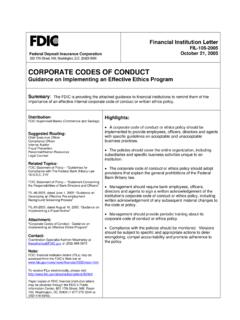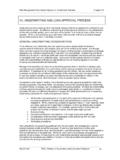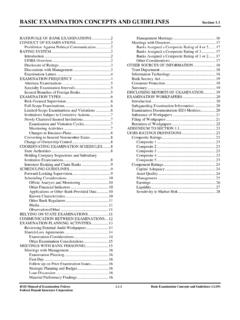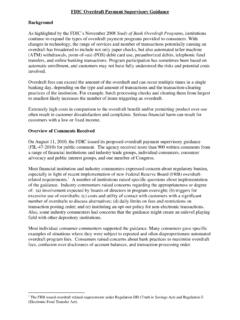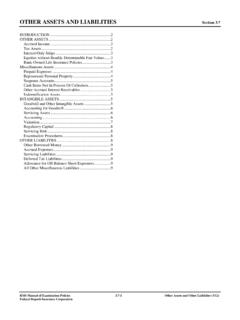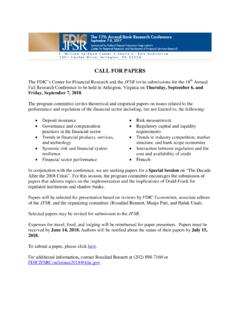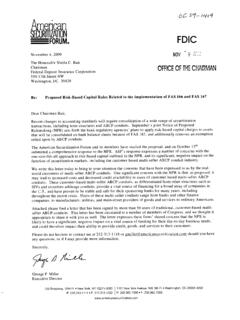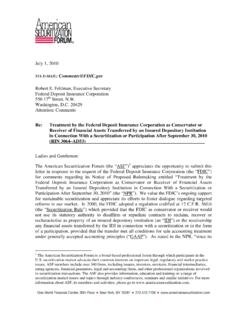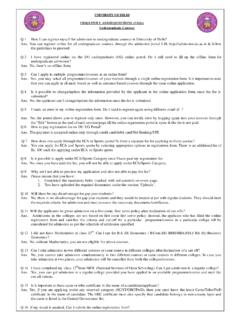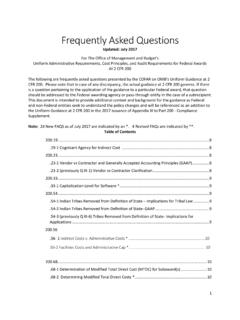Transcription of Frequently Asked Questions: Identity Theft Red …
1 Frequently Asked Questions: Identity Theft Red Flags and address discrepancies The staff of the Board of Governors of the Federal Reserve System ( FRB ), Federal Deposit Insurance Corporation ( FDIC ), National Credit Union Administration ( NCUA ), Office of the Comptroller of the Currency ( OCC ), Office of Thrift Supervision ( OTS ) (collectively the Federal Financial Institution Regulatory Agencies ) and the Federal Trade Commission ( FTC ) (collectively Agencies ) have developed these Frequently Asked questions ( FAQs ) to assist financial institutions, creditors, users of consumer reports, and card issuers in complying with the final rulemaking on Identity Theft Red Flags and address discrepancies implementing section 114 of the Fair and Accurate Credit Transactions Act of 2003 (FACT Act), 15 1681m, and section 315 of the FACT Act, 15 1681c, that amended the Fair Credit Reporting Act (FCRA).
2 1 Many of the questions the Agencies have received are answered in the supplemental information to the final These FAQs elaborate on the supplemental information where additional clarification is necessary and also explain the staff s view of how select provisions of the rulemaking apply to situations that were not specifically addressed in the final rules or supplemental information. Staff may supplement or revise these FAQs as necessary or appropriate in light of further questions and experience. The FTC will be issuing additional FAQs to answer questions specific to entities under FTC jurisdiction. These FAQs do not address the applicability of any other Federal or state laws. I. General FAQs 1. Do the Red Flags Rules, Card Issuers Rules, or address Discrepancy Rules contain record retention requirements?
3 These three Rules do not contain specific record retention requirements. However, financial institutions and creditors must be able to demonstrate that they have complied with the requirements of the Red Flags and Card Issuers Rules, and users of consumer reports must be able to demonstrate that they have complied with the requirements of the address Discrepancy Rules, in addition to any other applicable record retention requirements. II. Identity Theft Red Flags (Red Flags Rules and Guidelines)3 A. Scope 1 12 part 41 (OCC); 12 part 222 (FRB); 12 parts 334 and 364 (FDIC); 12 part 571 (OTS); 12 part 717 (NCUA); and 16 part 681 (FTC). The FTC recently renumbered the sections in 16 part 681 as follows: the address Discrepancy rule (originally ) was renumbered as ; the Red Flags rule (originally ) was renumbered as ; and the Card Issuers rule (originally ) was renumbered as For ease of reference, these FAQs refer to the original numbering scheme.
4 2 See 72 Fed. Reg. 63718 (Nov. 9, 2007). 3 12 and 16 (Section citations reference the uniformly numbered rules issued by the Federal Financial Institution Regulatory Agencies and the rules issued by the FTC.) 1. What is the relationship between the information security standards4 issued by the Agencies and the Red Flags Rules and Guidelines? The information security standards help to reduce Identity Theft ( a fraud committed or attempted using the identifying information of another person without authority ) by keeping individuals sensitive data from falling into the hands of an Identity thief. The information security standards require financial institutions to have reasonable policies and procedures that are designed to safeguard customer information and protect it from unauthorized access or misuse and to ensure the proper disposal of customer and consumer information.
5 By contrast, the Red Flags Rules and Guidelines seek to ensure that financial institutions and creditors are alert for signs or indicators that an Identity thief is actively misusing another individual s sensitive data, typically to obtain products or services from the institution or creditor. The Red Flags Rules require financial institutions and creditors that offer or maintain covered accounts to have policies and procedures to identify patterns, practices, or activities that indicate the possible existence of Identity Theft , to detect whether Identity Theft may be occurring in connection with the opening of a covered account or an existing covered account, and to respond appropriately. 2. Do the Red Flags Rules and Guidelines apply to all banks, savings associations, and credit unions, or only those that directly or indirectly hold transaction accounts belonging to consumers?
6 The Red Flags Rules and Guidelines implement section 114 of the FACT Act, 15 1681m, which applies to financial institutions and creditors. 5 The FCRA definition of financial institution applies to: (1) all banks, savings associations, and credit unions, regardless of whether they hold a transaction account belonging to a consumer; and (2) any other person that directly or indirectly holds a transaction account belonging to a consumer. Accordingly, all banks, savings associations, and credit unions are covered by the Red Flags Rules and Guidelines as financial institutions, whether or not they hold a transaction account belonging to a consumer. 3. Do the Red Flags Rules and Guidelines apply to banks and savings associations whose powers are limited to trust activities?
7 Yes. As described above, the Red Flags Rules and Guidelines apply to financial institutions as defined in the FCRA. Therefore, all banks and savings associations, including those whose powers are limited to trust activities, are covered by the Red Flags Rules and Guidelines. 4 12 part 30, app. B (OCC); 12 part 208, app. D-2 and Part 225, app. F (FRB); 12 part 364, app. B (FDIC); 12 part 570, app. B (OTS); 12 part 748, appendix A (NCUA); and 16 314 (FTC). 5 Section 114 of the FACT Act amended section 615 of the FCRA. 24. Do the Red Flags Rules and Guidelines apply to the foreign branches of banks?6 No. The FCRA, like many federal consumer protection laws, does not expressly address extraterritorial applicability.
8 Because a foreign branch of a bank is not an entity located in the United States, the Red Flags Rules and Guidelines do not apply. This conclusion is consistent with a number of consumer protection regulations that exclude foreign branches of banks from coverage. See Regulation Z, Official Staff Commentary, 12 part 226, supplement I, (c)-1; Regulation E, Official Staff Commentary, 12 part 205, supplement I, (a)-2; Regulation M, Official Staff Commentary, 12 part 213, supplement I, Other regulations that impose customer information collection and verification requirements, such as the Customer Identification Program regulations implementing the USA PATRIOT Act, do not apply extraterritorially. See 31 Nevertheless, as a matter of safety and soundness, financial institutions are strongly encouraged to implement an effective Identity Theft prevention program throughout their operations, including in their foreign offices, consistent with local laws.
9 5. What are functionally regulated subsidiaries of banks and savings associations that are referenced in the scope sections of the Identity Theft Red Flags regulations issued by several of the Agencies? The term functionally regulated subsidiary is defined in section 5(c)(5) of the Bank Holding Company Act of 1956, as amended by the Gramm-Leach-Bliley Act (12 1844(c)). The term means any company that is not a bank holding company or depository institution and that is: a broker or dealer that is registered under the Securities Exchange Act of 1934; a registered investment adviser, properly registered by or on behalf of either the Securities and Exchange Commission or any state, with respect to the investment advisory activities of such investment adviser and activities incidental to such investment advisory activities; an investment company that is registered under the Investment Company Act of 1940.
10 An insurance company, with respect to insurance activities of the insurance company and activities incidental to such insurance activities, that is subject to supervision by a state insurance regulator; or an entity that is subject to regulation by the Commodity Futures Trading Commission, with respect to the commodities activities of such entity and activities incidental to such commodities activities. 6. Are brokers, dealers, investment advisors, or investment or insurance companies, including those that are subsidiaries of a bank or savings association, covered by the Red Flags Rules and Guidelines? 6 The FTC will address this issue similarly for the foreign subsidiaries of entities under FTC jurisdiction in the separate FAQs it will be issuing as referenced above.
